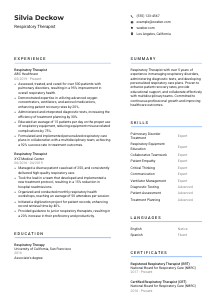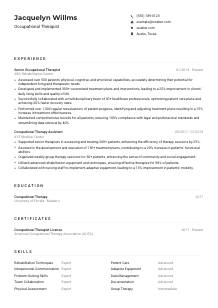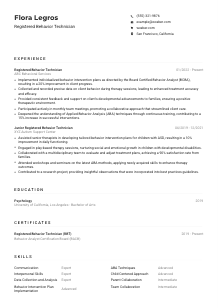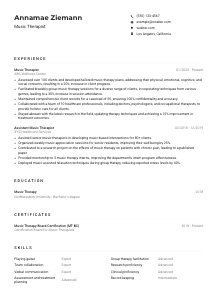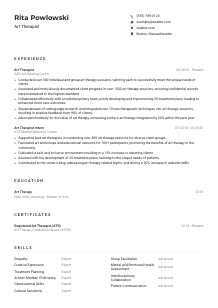Respiratory Therapist Resume Example
Helping lungs, but feeling breathless about your resume? Inhale this Respiratory Therapist resume example, exhaled with Wozber free resume builder. Discover how to oxygenate your therapy talents to fit the job ventilations, leaving your career as refreshed and recovered as the patients you care for!
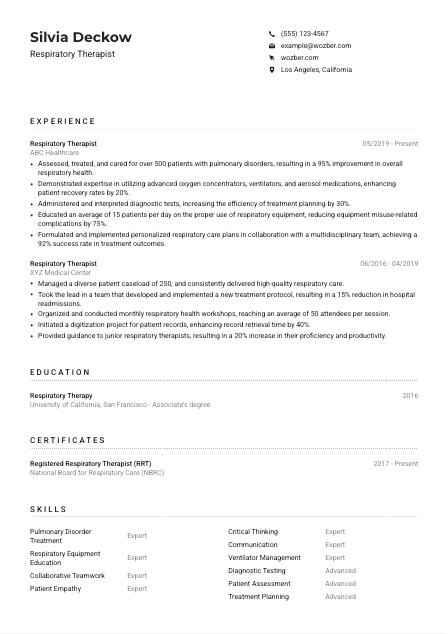
How to write a Respiratory Therapist resume?
Embarking on the journey to clinch a Respiratory Therapist role? Your resume isn't just a piece of paper; it's your personal billboard, illuminating your dedication, skills, and the specialized care you bring to patients with breathing challenges. With the help of this guide and the Wozber free resume builder, you're about to create an ATS-compliant resume that perfectly aligns with your dream job's demands. Together, let's draft a resume that not only passes through the ATS resume scanner with flying colors but also compellingly tells your professional story!
Personal Details
The Personal Details section is your resume's gateway. It's more than just a formality; it's your chance to make a great first impression in the language of a Respiratory Therapist. Armed with these expert pointers, let's ensure your contact information not only aligns with the job's logistics but also adds a personal touch.
1. Brand Thyself
Begin by clearly listing your name, using a readable font that makes it stand out. Your name is not just a label, it's your brand. By positioning it prominently, you open the door to your professional narrative.
2. Job Title Alignment
"Respiratory Therapist" isn't just your goal; it's your identity. Place it right below your name to show alignment with the position you're eyeing. This clarity immediately showcases your professional dedication to any hiring manager glancing at your resume.
3. Key Contact Highlights
Ensure your contact information is precise and professional. A phone number and an email address are essentials. A pro tip: Your email should reflect professionalism; stick to variations of your name without nicknames or numbers that could date you.
4. Geographical Greenlight
Mentioning "Los Angeles, California" aligns with the job's location requirement, subtly assuring the hiring team of your readiness or willingness to be part of the local team. This small detail tackles any potential relocation questions up front.
5. Digital Professional Presence
In today's digital age, including a LinkedIn profile URL can be a game-changer. Ensure it's updated and echoes your resume. This is your chance to showcase a well-rounded professional profile, complete with recommendations and endorsements.
Takeaway
Polishing your Personal Details section is like rolling out the red carpet for your resume. Every aspect, from your name's font to the inclusion of a professional LinkedIn profile, is an invitation for the hiring manager to learn more about you. Ensure these details are precise, professional, and in harmony with your desired role. With this polished entryway, you're ready to lead them into the depths of your professional prowess.





Experience
In the heart of your resume lies the Experience section, a testament to your journey as a Respiratory Therapist. Here, you don't just list jobs; you narrate your impact, your growth, and your unwavering commitment to patient care. Follow these steps to frame your experience in a way that resonates deeply with the hiring manager, striking a perfect balance between professional achievements and humane care.
- Assessed, treated, and cared for over 500 patients with pulmonary disorders, resulting in a 95% improvement in overall respiratory health.
- Demonstrated expertise in utilizing advanced oxygen concentrators, ventilators, and aerosol medications, enhancing patient recovery rates by 20%.
- Administered and interpreted diagnostic tests, increasing the efficiency of treatment planning by 30%.
- Educated an average of 15 patients per day on the proper use of respiratory equipment, reducing equipment misuse‑related complications by 75%.
- Formulated and implemented personalized respiratory care plans in collaboration with a multidisciplinary team, achieving a 92% success rate in treatment outcomes.
- Managed a diverse patient caseload of 250, and consistently delivered high‑quality respiratory care.
- Took the lead in a team that developed and implemented a new treatment protocol, resulting in a 15% reduction in hospital readmissions.
- Organized and conducted monthly respiratory health workshops, reaching an average of 50 attendees per session.
- Initiated a digitization project for patient records, enhancing record retrieval time by 40%.
- Provided guidance to junior respiratory therapists, resulting in a 20% increase in their proficiency and productivity.
1. Dissect Job Requirements
Begin by mining the job description for golden nuggets - the skills and experiences prized by your potential employer. For instance, if the job emphasizes pulmonary disorder treatment, make sure to highlight your direct experience in this area.
2. Chronology & Context
List your roles in reverse chronological order, giving each a spotlight. Include the job title, the location, and your tenure to provide a clear timeline. But, go beyond mere dates; give each role a backstory that spotlights your contributions and growth.
3. Achievement Amendments
Illustrate your professional story with achievements that speak volumes. Rather than stating you 'used ventilators,' specify that you 'enhanced patient recovery rates by 20% through advanced ventilator management.' This specificity turns duties into accomplishments with measurable impacts.
4. Numerical Narratives
Whenever possible, quantify your achievements. Did you educate a certain number of patients daily on respiratory equipment? Did this education decrease equipment misuse? Numbers not only back up your claims but also offer a tangible measure of your impact and dedication.
5. Relevance Over Rhetoric
Each bullet point should be a testament to how your role and achievements align with the job description. Avoid cluttering with unrelated duties; focus on those moments when you made a difference, especially those that echo the job's key demands.
Takeaway
Crafting an Experience section that resonates with hiring managers means showcasing not just what you've done, but how you've made a difference. It's about painting a picture of your continuous growth, your dedication to patient care, and your ability to meet and exceed challenges. Let each role tell a chapter of your story, share your victories, your learning curves, and how you've left a positive mark. This is your professional saga; make it compelling.
Education
The rigor of your educational background in Respiratory Therapy stands as the cornerstone of your qualification. While listing your degree is a mere formality, portraying the depth of your academic journey can significantly strengthen your resume. Dive into how to magnify the impact of your Education section, ensuring it showcases not just knowledge, but commitment and specialization.
1. Precise Program Alignment
Match your academic achievements with the job's educational prerequisites. For instance, spotlighting your "Associate's degree in Respiratory Therapy" exactly meets the job's request, reinforcing your eligibility from the get-go.
2. Clarity & Conciseness
Structure this section with straightforward clarity. List your degree, your major, and the institution, followed by your graduation year. This clear, direct approach ensures your qualifications are immediately recognizable.
3. Degree Specified Success
Ensure the title of your degree precisely reflects the role's requirements. In the example of an "Associate's degree in Respiratory Therapy," this direct match leaves no room for guesswork regarding your specialized training.
4. Coursework That Counts
If you're early in your career, it can be beneficial to list relevant coursework. For instance, detailing a course on "Advanced Ventilator Management" directly demonstrates your specialized knowledge and readiness for the role.
5. Achievements That Accentuate
Don't shy away from highlighting any honors or relevant extracurriculars. Were you part of a research project on pulmonary rehabilitation? Such details add depth to your profile, showcasing a proactive engagement with your field beyond the classroom.
Takeaway
Your Education section is more than a list of degrees; it's a mirror reflecting your commitment to your craft. By aligning your academic achievements with the job's requirements and highlighting specialized courses and honors, you're not just proving you're qualified - you're showcasing your dedication to advancing in the field of Respiratory Therapy. Let your educational journey be both your foundation and your beacon as you advance in your career.
Certificates
In the ever-evolving field of Respiratory Therapy, your certificates are like badges of honor, showcasing your commitment to continuous learning and excellence. Here's how to ensure your Certificates section not only meets the job's demands but also highlights your proactiveness and depth of specialized knowledge.
1. Direct Demand Match
Start by listing certificates that directly fulfill the job's requirements. For example, including "Registered Respiratory Therapist (RRT)" and "Certified Respiratory Therapist (CRT)" demonstrates your credentials right off the bat, showing compliance with key qualifications.
2. Quality Over Quantity
Prioritize certificates that matter most to the role. It's better to list a few highly relevant certifications than a long list of vaguely related ones. This approach assures the hiring manager of your specific expertise and preparedness.
3. Timeliness & Transparency
If your certifications have expiration dates or were recently attained, include these details. This transparency not only demonstrates your current competency but also your commitment to staying updated in your field.
4. Continuous Learning Commitment
The healthcare landscape, especially respiratory therapy, is continuously advancing. Show your commitment to staying at the forefront of what's new and vital in your profession by regularly updating and acquiring new certifications.
Takeaway
Your certificates are not just tokens of your expertise; they're a testament to your ongoing dedication to excellence in Respiratory Therapy. By selecting and presenting them with insight, you not only align with the job's direct demands but also illustrate your continuous pursuit of growth. Let these seals of expertise boldly state your preparedness and passion for the role.
Skills
Your skills section is where you get to shine a spotlight on the specific abilities that make you an outstanding candidate for the Respiratory Therapist position. Tailoring this section to match the job's needs is crucial, ensuring each skill speaks to your capability and fit for the role. Here's how to curate your skills list to resonate most effectively with hiring managers.
1. Skills Dissection
Your first step is to identify both the explicit and implicit skills sought in the job description. For instance, if 'Ventilator Management' and 'Patient Assessment' are mentioned, these are your cues to prioritize them in your list.
2. Align & Shine
List skills that align directly with the job's requirements, focusing on both hard skills like 'Diagnostic Testing' and soft skills like 'Empathy for Patients.' The balance shows you're not just technically adept but also possess the compassion vital for patient care.
3. Clean & Orderly Presentation
Curate your list to include only the most pertinent skills, keeping it neat and impactful. A cluttered skills section can dilute the impact of your most relevant abilities. Let each skill be a beacon, clearly illuminating your suitability for the role.
Takeaway
Approaching your skills section with precision and purpose turns it into a compelling showcase of your professional capabilities. Each listed skill is a promise of the value you'll bring, underlining your readiness and enthusiasm for the Respiratory Therapist role. Let your selection be strategic, ensuring that your proficiency breathes through each word, ready to meet the demands of the position head-on.
Languages
In a diverse city like Los Angeles, your ability to speak multiple languages could be the bridge to better patient relationships and care. While the job may only specify proficiency in English, additional linguistic skills can elevate your profile, reflecting your readiness to connect with a broader patient pool. Let's unpack how to effectively incorporate your linguistic prowess into your resume.
1. Language Prerequisites
The role specifies, "Proficiency in English language for professional communication is essential." Secure this as your baseline, listing English proficiency at the top. This acknowledgment tick-boxes the primary requirement.
2. Beyond the Basics
Following English, list any additional languages you're proficient in. Even if not mentioned in the job description, languages like Spanish, owing to California's diverse population, can be particularly advantageous, showcasing your ability to communicate with a wider array of patients.
3. Honesty & Clarity
When stating your language skills, be straightforward about your proficiency levels. From 'Native' to 'Basic,' clarity in your linguistic capabilities allows for transparent expectations and shows your honesty.
4. Global Readiness
In a position where interaction and patient education are pivotal, being multilingual can be a substantial asset. It speaks to your global mindset and adaptability, qualities highly sought after in healthcare settings.
5. Role's Scope Understanding
Consider the role's scope and how your language skills might enhance your effectiveness. In locations with high non-English speaking populations, being bilingual or multilingual can greatly improve patient care and outcomes.
Takeaway
Showcasing your language skills does more than meet a checkbox; it opens doors to deeper patient connections and demonstrates a readiness to serve in a diverse community. Let your resume reflect not just your professional expertise but also your linguistic adaptability, enriching your offerings as a candidate. Embrace your global voice; it's a powerful tool in the realm of healthcare.
Summary
The Summary section is where you distill your professional essence into a few compelling lines. It's your chance to immediately capture the hiring manager's attention, weaving in your experience, skills, and dedication in a narrative that resonates with the spirit of a Respiratory Therapist. Crafting a memorable summary requires strategy and insight; let's explore how to make yours stand out.
1. Job Essence Understanding
Start by absorbing the essence of the job description, pinpointing the qualities and experiences that define an ideal candidate. This understanding forms the backbone of your summary.
2. Professional Introduction
Kick things off with a succinct statement about your role and years of experience, positioning yourself firmly within the Respiratory Therapist realm. For example, "Respiratory Therapist with over 5 years of experience..." sets the stage with authority.
3. Skillful Synthesis
Draw in a selection of your top skills and achievements that mirror the job's requirements. Phrases like "proven to enhance patient recovery rates" or "collaborate effectively with multidisciplinary teams" showcase your contributions and fit for the role.
4. Brevity & Impact
Craft your summary to be a tight, impactful window into your professional identity. Use this space to hint at your journey, your achievements, and what drives you, inviting the reader to dive deeper into your resume.
Takeaway
Your Summary is the opening act, setting the tone for your resume. By concisely articulating your experience, skills, and the value you bring, you're not just introducing yourself; you're making a compelling case for why you're the ideal candidate. Let your professional essence shine in these few lines, making a memorable first impression that beckons the hiring manager to read on.
Launching Your Success Story
Congratulations, you've now traversed the landscape of crafting a standout Respiratory Therapist resume! Armed with these insights and the Wozber free resume builder, you're equipped to create an ATS-compliant resume tailored to your dream job. Remember, each section of your resume is a building block in your professional narrative. By carefully curating your experience, education, certifications, and skills, you set the stage for success.
The healthcare world needs your expertise and compassion; let your resume be the key that opens doors to new opportunities. Breath success into your career, one section at a time. Let's get started!

- Graduate of an accredited Respiratory Therapy program with a minimum of an Associate's degree.
- Active and unrestricted Respiratory Therapist license in the state of practice.
- Current certification by the National Board for Respiratory Care (NBRC) as a Registered Respiratory Therapist (RRT) or a Certified Respiratory Therapist (CRT).
- Minimum of 2 years of clinical experience as a Respiratory Therapist.
- Strong interpersonal and communication skills, as well as the ability to work collaboratively in a multidisciplinary team.
- Proficiency in English language for professional communication is essential.
- Must be located in or willing to relocate to Los Angeles, CA.
- Assess, treat, and care for patients with pulmonary disorders.
- Use a variety of devices, such as oxygen concentrators, ventilators, and aerosol medications to manage patient respiratory conditions.
- Perform diagnostic tests, including measuring lung capacity and conducting sleep studies.
- Educate patients and their families on the proper usage of respiratory equipment and techniques to ensure the best outcomes.
- Collaborate with physicians and other healthcare professionals to develop and implement respiratory care plans.






